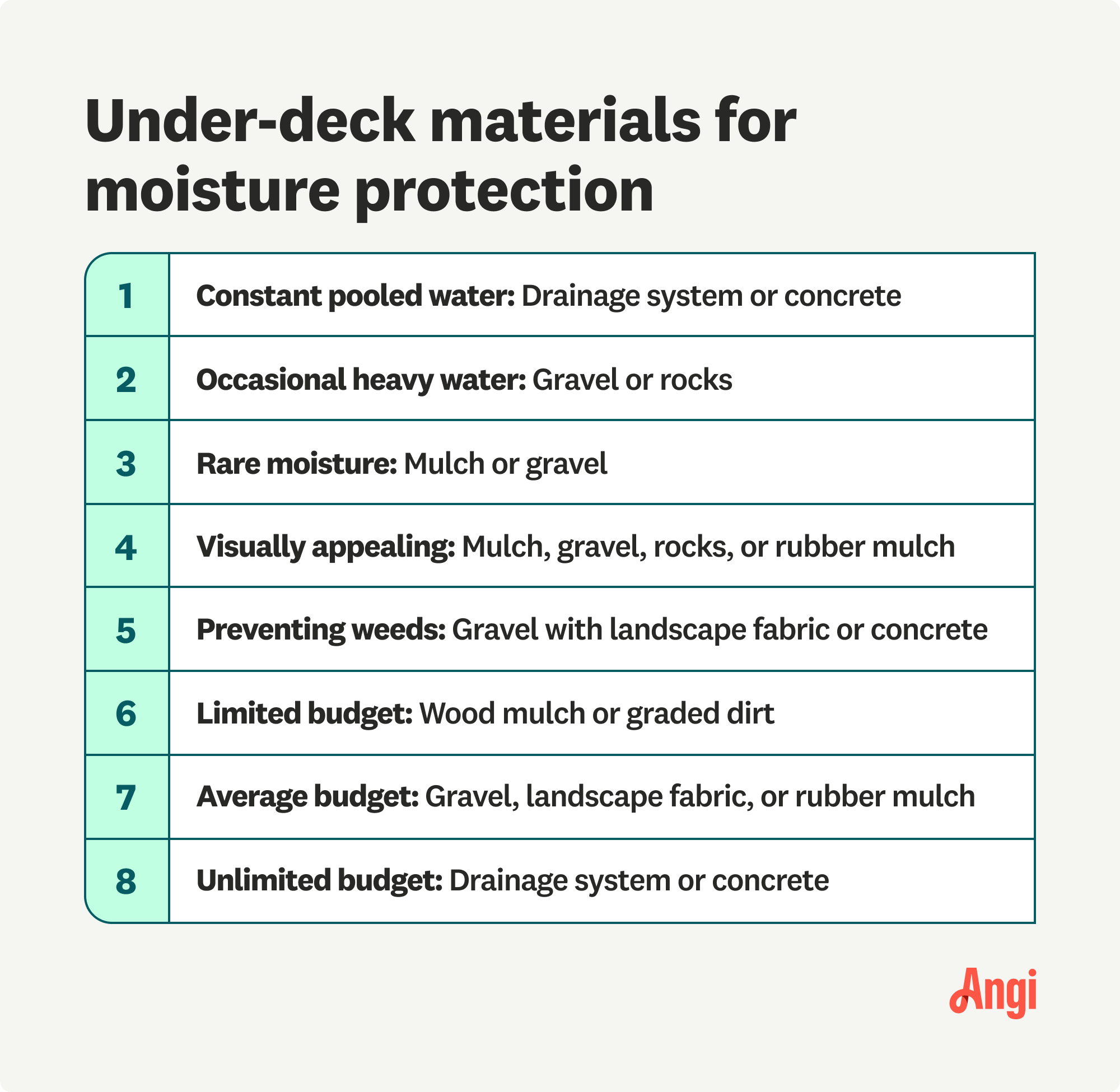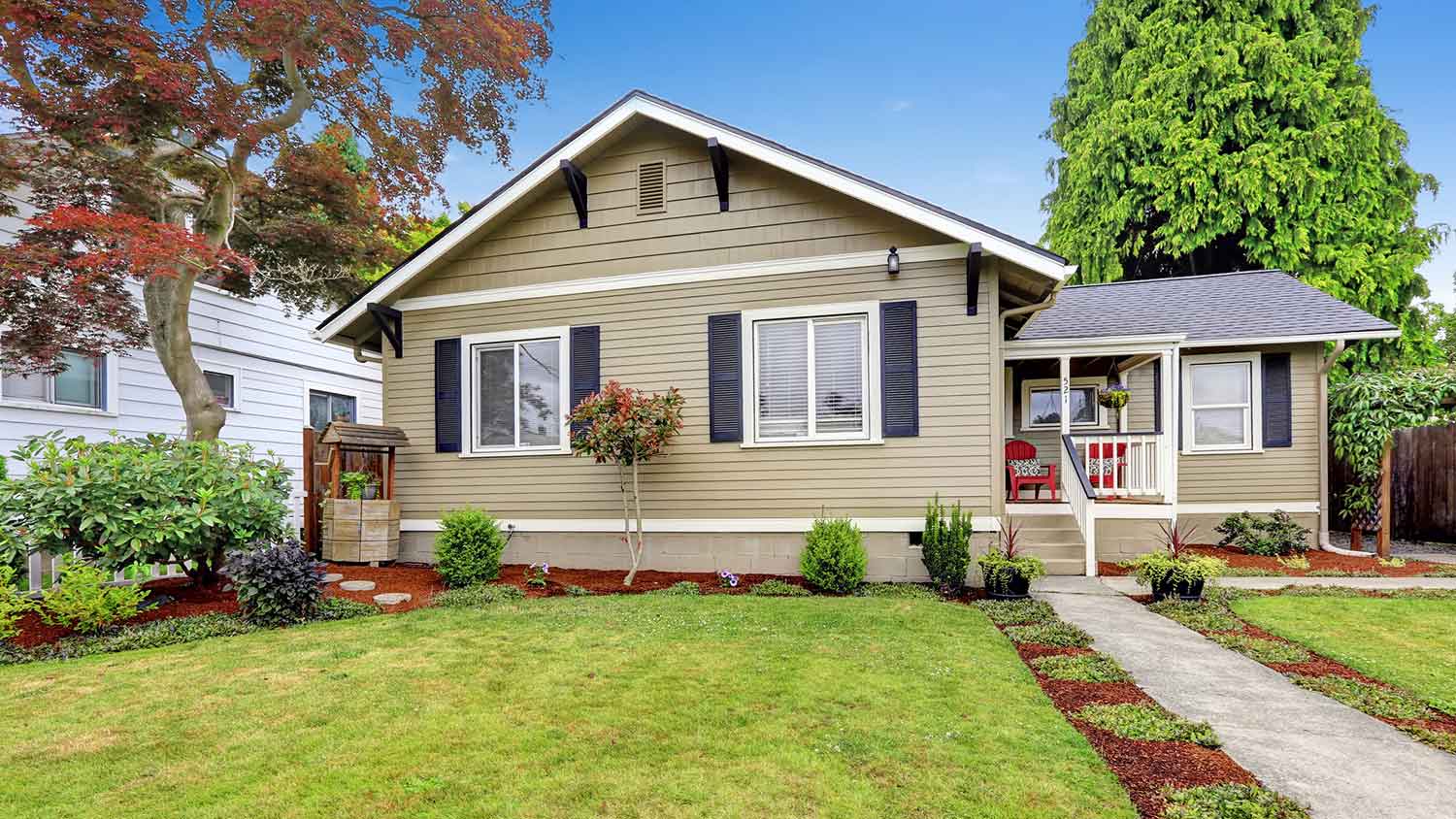
Refinishing your deck is a great way to restore its appearance and fall in love with your outdoor space. Use this guide to learn how much it costs based on factors like size and type.
Let’s keep things nice and dry under there


Excessive moisture under a deck can cause erosion.
Constant standing water could damage the home’s foundation.
Proper grading under the deck moves water away from the home.
Gravel and landscape fabric limit standing water and weeds.
A drainage system under the deck works for excessive water.
Enjoying a calm summer evening on your deck while watching the sunset can feel like the perfect end to the day. And while you may maintain your deck well, it’s important to not forget about what goes on below deck. Guarding against moisture, weeds, and other unwanted issues gives your deck a longer lifespan while protecting your home’s foundation.
When you are wondering what to put under decks for moisture protection, you have multiple options. Here’s what to put under your deck to keep moisture issues at bay.
When you aren’t sure what to put under a deck for heavy moisture, a drainage system may be your best bet. Installing this type of system can be challenging after you build the deck, because of the potentially tight space in which to work. Consider building the drainage system as you are preparing to install a deck, if possible.
To prepare the ground under the deck for the draining system, you’ll need to install troughs to carry the water to a different area on the property. You may need to install a French drain to carry the water from under the deck to a location farther away from your home’s foundation.
One advantage of using a draining system is that you now have a space where you can store kids’ toys or lawn maintenance equipment. You don’t have to worry about these items sitting in water puddles, thanks to the drainage system.
If you rarely or never have standing water under the deck, you may not need to install a draining system at all. Instead, you may be able to use a layer of gravel to allow water to slowly reach the dirt underneath without causing erosion.
Using rocks under decks offers a number of benefits, including:
Limiting the growth of weeds.
Preventing dirt from washing into your lawn.
Slowing the movement of rainwater during natural runoff.
Creating a pleasing visual underneath the deck.
Install a layer of gravel at least a few inches in thickness to deliver the benefits you are seeking. If you can afford a layer of gravel several inches thick, it will block weeds and prevent erosion even better than the thinner layer of gravel.
If you want the rocks to serve as a visual landscaping feature, river rock has a great look. You could then place a few larger rocks or boulders under the deck on top of the river rock for additional elements.
Crushed stone has rough edges, so we wouldn’t recommend it if you plan to walk on the rocks under the deck, but it is a less expensive option than river rock.
Landscape fabric is another option to put under the deck for moisture that is not heavy or that does not create standing water very often. Landscape fabric will hold dirt in place and will prevent weeds from growing, protecting the visual appeal of the space.
You should place gravel or rocks over the landscape fabric for the best results. Without a thick layer of gravel, blowing dirt may collect on top of the fabric, eventually allowing weeds to grow. Rocks over the top of the fabric also create a better visual than the fabric alone.
When installing landscape fabric, you may want to install a barrier of treated wood landscape timbers around the perimeter of the area. You then can attach the fabric directly to the wood, keeping it in place better than securing it to the dirt ground. The wood barrier will hold the gravel in place as well, keeping stray pebbles and rocks out of your lawn.
Woven stabilization fabric is the best material to use. You want water to slowly seep through the fabric to the dirt underneath for the best drainage. If you place plastic landscaping material under the deck, the water cannot seep through it easily. The water will either run into the yard or will remain in place under the deck.
Although it is an expensive choice, some people prefer to place a concrete slab under the elevated deck.
If your elevated deck allows quite a bit of rain water to fall through the slats to the ground underneath, concrete will not erode. Additionally, with the proper grading in the concrete, the water will flow efficiently away from the home’s foundation into the yard.
If you want to build an outdoor kitchen under the deck, a concrete slab also gives you a sturdy base for your kitchen equipment.


If you live in a primarily dry climate where you rarely have any moisture under your deck, you have a few other materials you can use. These materials will deliver a pleasing look, but they are not overly effective for moving a lot of water safely away from the home’s foundation and away from the area under the deck.
Mulch: Wood mulch is a popular landscaping material, because it’s inexpensive and it looks good. However, it tends to retain moisture, which may cause problems with insects and other pests moving into the area under the deck. It also will decompose, necessitating regular replacement.
Rubber mulch: If you want a material that won’t decompose, rubber mulch works well. It typically consists of recycled rubber, making it eco-friendly, and you can order it in almost any color. However, it could give off an odor, especially if the area under the deck receives direct sunlight in the summer.
Sand: If you want to create a play area for the kids under the deck, you could add sand and make a giant sandbox. However, sand will blow around. If you have heavy rain, it will erode quickly. Sand is not the best material for use under a deck for moisture concerns, but some people do use it.
Building a deck is a big expense that has financial ripple effects. The cost to build a deck averages around $8,200, and your bottom line will depend heavily on deck size, chosen materials, and the labor cost in your area, which will make up 40% of your total.
Additional expenses include having mulch delivered and installed for moisture protection, running from $100 to $350. Homeowners can expect costs for other fillers, like sand, to be anywhere from $5 to $150 per cubic yard.
Your new deck can also trigger higher property taxes and insurance premiums, so it’s worth investigating before you ring up a contractor. That said, this isn’t just money out the door. A beautifully constructed deck made from quality materials can boost your home’s resale value, offering an ROI between 40% and 52%.
Building a deck expands your living space and adds value to your home, but thoughtful planning is key. From materials to layout, every decision impacts safety, durability, and maintenance. Before choosing what goes underneath, think about how you’ll use the space, whether for storage, a shaded patio, or just keeping the area dry and tidy after rain.
While tackling this as a DIY project is possible, hiring a contractor ensures great results and long-term protection. A local deck builder can properly grade the area to direct water away from your home, install the right moisture barriers, and recommend the best materials for your specific climate and soil conditions. Their expertise saves you time and guesswork and helps extend your deck's life, preventing costly issues down the road.
From average costs to expert advice, get all the answers you need to get your job done.

Refinishing your deck is a great way to restore its appearance and fall in love with your outdoor space. Use this guide to learn how much it costs based on factors like size and type.
Deck replacement costs depend on materials, any structural damage you need to fix, and more. This guide explores how much it costs to replace or repair a deck.

Are you wondering what factors might affect a wraparound porch’s cost? Budget for this rustic and charming addition with our cost guide.

Deck board replacement can keep your outdoor space looking good and safe to use. Learn how to replace deck boards yourself.

Discover the cost to build an arbor in your yard. Learn about average prices, key cost factors, and tips to save on your arbor installation project.

If your deck is in bad shape, this deck repair checklist will help you inspect, clean, maintain, and repair it without missing any vital steps in the process.